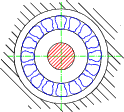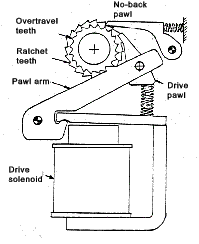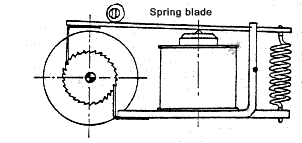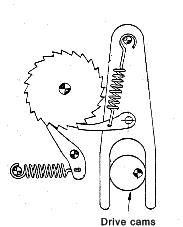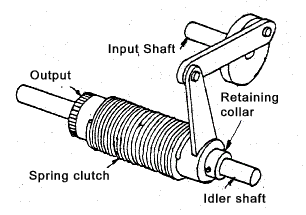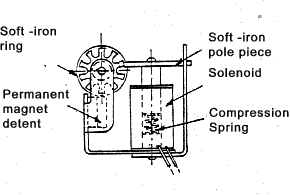| |
Mechanism general notes
Ratchet Mechanisms
More details on Ratchet Mechanisms are to be found in the links below the table
|
Ratchets There are many forms of ratchets often requiring some ingenuity in their
derivation. Ratchets are used widely in lifting equipment to lock the
motion and prevent reverse rotation when the input force is removed.
Ratchets can also be used to drive a motion in one direction and allow free-wheeling in the reverse direction. The best example of
this application is the bicycle chain drive
T The pawl ratchet as shown above is a very simple toothed wheel with a pawl allowing
free rotation in only one direction. The Sprag clutch is a modern variation working using
a number of sprags between concentric rings. When the outer ring rotates in one direction relative
to the innner rings the sprags all pivot a little away from the outer wall allowing
free movement. If the outer ring reverses the sprags all pivot the other way and their geometry is such that they lock up the rings
together.. TThe pawl ratchet is simple, versatile, inexpensive and reasonably accurate. It is used in all sizes, shapes and power capacities.
The action of a ratchet can be either harsh or smooth depending on the configuration
of teeth & pawls, accuracy of design and manufacture and the method used to drive the
pawls. When a solenoid or spring is used as in the mechanism below the drive pawl strikes the ratchet
wheel with an impact and the wheel will jump ahead if the load is sufficiently light.
This is one of the principal drawbacks of the plain ratchet. A brake or detent, or careful attention to load
will ensure accurate indexing. The unit shown below includes a second set of teeth which engage a projection on
the pawl arm to prevent overtravel.
Spring Blade Ratchet TThe ratchet shown below uses flat springs as drive and holding pawls. with proper heat-treatment this type of drive will give long life under light loading. Indexing rates can be as high as several a second and the wheel can be indexed with accuracies of about one-tenth of a degree. Spring-blade ratchets are typically used to wind springs and drive printed-circuit commutators or timing cams..
TIn this type of ratchet as shown below the cam can be design so that the drive pawl
has very little kinetic energy when it strikes the wheel: this reduces impact & overtravel.
The unit shown below illustrates another variation of cam input. The ratchet
wheel is indexed in a clockwise direction for either clockwise or counterclockwise rotation
of the input shaft. Although the ratchets shown are normally used in
small counters, the same configuration can be used to drive loads of kW size.
Permissible indexing rates depend on the design strength
of the various parts...
TIn addition to the more common types of ratchets i.e pawl and toothed-wheel mechanisms other types of indexing drives can be classed as ratchets. The main feature is that an oscillating member works a one way clutch to index a wheel. One typical system is shown below. A reciprocating linkage drives the output shaft by means of a one-way spring clutch. Many other types of clutches can be used in a similar arrangement.
TThe figure below shows a fully magnetic ratchet. When the solenoid is energised the soft-arm pole piece fastens to a soft iron tooth on the wheel and indexes the wheel. Wehn the solenoid is turned off, a compression spring raises the pole to meet the next tooth , whilst a permanent magnet holds the wheel. this method is useful for driving a wheel inside a hermetically sealed housing..
|
Links to Mechanism Design
|
|
Machine_Parts_Index
Mechanism general notes

